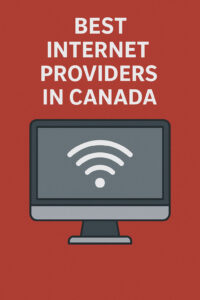Living in rural Canada does not mean you need to settle for slow or frustrating internet. Thanks to major investments in satellite, fixed wireless, DSL, and LTE technologies, rural communities now have more reliable choices than ever before. Whether you run a farm in Saskatchewan, work remotely from northern Ontario, or simply want dependable streaming at your cottage, this guide will help you find the best rural internet providers in Canada. We compare coverage, speeds, pricing, and data policies, so you can pick a plan that truly fits your lifestyle.
Why Rural Internet Access Matters
High-speed internet is no longer optional, it’s essential for education, telehealth, modern farming, remote work, and keeping connected with family and friends. The digital divide between urban and rural households has been shrinking, but gaps remain. To close this, the Canadian government’s Universal Broadband Fund is working toward a goal of giving 98% of Canadians access to at least 50 Mbps download and 10 Mbps upload speeds by 2026, with near-total coverage by 2030.
Types of Rural Internet in Canada
- Satellite Internet Works virtually anywhere in Canada, including remote northern regions. Best for hard-to-reach locations with no wired infrastructure.
- Fixed Wireless Connects homes via nearby towers. Delivers strong speeds but requires line-of-sight.
- DSL Runs over existing phone lines. Available in semi-rural towns but limited in speed.
- Cellular/LTE Internet Uses mobile networks (4G/5G) to provide home internet. Often capped, but quick to install.
Best Rural Internet Providers in Canada
Here are some of the most recognized providers offering rural internet solutions, with their main service types, coverage, and pricing details:
| Provider | Service Type | Download Speed | Starting Price | Data Cap | Coverage |
|---|---|---|---|---|---|
| Xplore | Satellite, Fixed Wireless, 5G | Up to 100 Mbps | From $59.99 | Unlimited (Fair Use Policy) | Nationwide |
| Starlink | Satellite (Low-Earth Orbit) | 25–220 Mbps | $140 + equipment | Unlimited | Virtually everywhere |
| Rogers Rural Internet | Fixed Wireless, LTE | Up to 50 Mbps | From $59.99 | Up to 500 GB | Ontario, Atlantic Canada |
| Bell Smart Hub | LTE Wireless | Up to 50 Mbps | From $60 | Up to 350 GB | Ontario, Quebec, Atlantic Canada |
| Telus Smart Hub | LTE Home Internet | Up to 50 Mbps | From $85 | Up to 500 GB | BC, Alberta, Quebec (select) |
| Netcrawler | DSL, Fixed Wireless | Up to 50 Mbps | From $49.95 | Unlimited | Ontario, Manitoba |
| CanNet | DSL | Up to 25 Mbps | From $39.95 | Unlimited | Ontario, Quebec, Alberta |
Provider Spotlights
Xplore
Xplore (formerly Xplornet) is the leading name in rural internet across Canada. They specialize in connecting small towns, farms, and remote homes using a mix of satellite, fixed wireless, and now 5G home internet. With unlimited data plans and ongoing infrastructure upgrades, Xplore is often the first and best choice for rural Canadians who need dependable service without strict data caps.
- Why choose Xplore: Wide availability, unlimited data, and improved speeds with 5G backhaul.
- Ideal for: Remote homes, farms, and rural businesses.
Starlink
Starlink, powered by SpaceX, delivers satellite internet using low-earth orbit technology that reduces latency. It is available almost everywhere in Canada, even in the most isolated regions. The hardware cost is high, but it provides unmatched performance in truly remote areas.
Rogers Rural Internet
Rogers offers LTE-based rural internet in Ontario and Atlantic Canada. It’s a good fit if you live within their tower coverage, but keep in mind that data caps apply to most plans.
Bell Smart Hub
Bell’s Smart Hub brings LTE internet to rural households with plans up to 350 GB. It’s quick to install and works well for moderate usage such as browsing, video calls, and some streaming.
Telus Smart Hub
Telus Smart Hub serves rural BC, Alberta, and Quebec. With higher data allowances, it’s a good choice for families who need steady connectivity for school and remote work.
Netcrawler
Netcrawler focuses on affordability with DSL and fixed wireless plans. Their unlimited data options and no-contract terms make them attractive for budget-conscious households in semi-rural areas.
CanNet
CanNet provides inexpensive DSL-based internet in Ontario and Quebec. While speeds are more modest than cable or fiber, their unlimited usage makes them appealing to rural families that just need basic connectivity at the lowest price.
Pros and Cons of Rural Internet Technologies
| Technology | Pros | Cons |
|---|---|---|
| Satellite | Available almost anywhere; Starlink offers faster speeds than legacy satellite | High equipment cost, weather sensitive, latency higher than wired |
| Fixed Wireless | Strong speeds, lower latency, great for streaming and work | Needs line-of-sight; performance varies with distance from tower |
| DSL | Stable, affordable, widely available in semi-rural towns | Lower speeds; aging infrastructure |
| LTE / 5G Home Internet | Fast setup, growing 5G coverage, portable options | Data caps, speeds vary in fringe coverage areas |
Tips for Choosing Rural Internet
- Always check your exact address on the provider’s coverage map.
- If you stream or work from home, prioritize unlimited data.
- Ask about installation fees, modem costs, and whether BYOD (bring your own device) is allowed.
- For gamers or video calls, prioritize low latency over high download numbers.
- Consider bundle discounts if you also need TV or phone service.
Government Support for Rural Connectivity
The Canadian government has launched several programs to improve rural internet access:
- Universal Broadband Fund $3.2 billion to expand high-speed access.
- Canada Infrastructure Bank Partners with ISPs to build rural broadband infrastructure.
- Connect to Innovate Supports backhaul builds in remote communities.
Final Thoughts
While big cities get the fastest gigabit fiber, rural Canadians now have strong alternatives that close the digital divide. Providers like Xplore lead the way with satellite, fixed wireless, and 5G solutions built for rural life. Starlink, Bell, Rogers, Telus, and independents like Netcrawler and CanNet all add options that make it easier to find a plan that suits your needs and budget. Before you sign up, compare your choices, check availability at your address, and confirm the true monthly cost. With the right provider, rural internet in Canada can finally feel reliable, fast, and truly unlimited.






